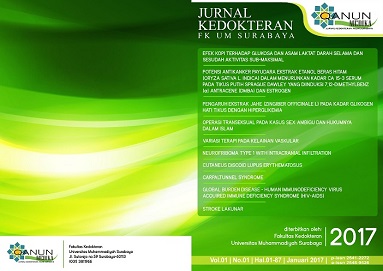Abstract
Stroke merupakan penyebab kematian terbesar keempat di Amerika setelah penyakit jantung, kanker, dan penyakit pernafasan kronis. Angka kematian penderita stroke mencapai 55 %. Dari seluruh kasus stroke, angka kejadian stroke iskemik mencapai 87 % dibandingkan dengan stroke perdarahan. Diantara kasus stroke iskemik tersebut, Oxfordshire Community Stroke Project (OCSP) menyebutkan 25% adalah stroke lakunar. Stroke lakunar cukup penting mengingat sekitar satu dari empat pasien iskemia otak adalah stroke lakunar. Subtipe ini disebabkan oleh adanya oklusi arteri perforator yang didasari oleh adanya proses patologis pada pembuluh darah kecil, dengan faktor resiko utama adalah hipertensi dan diabetes mellitus. (QM 2017;01:78-87)
Full text article
References
Arboix, A. (2011) Lacunar infarct and cognitive decline. Neurother. 9, pp.1251–1254
Arboix, A., Marti, JL. (2009) Lacunar Stroke. Neurother. 9, pp.179–
Arboix, A., Massons, J., Eroles, LG. et al. (2010). Clinical predictors of lacunar syndrome not due to lacunar infarction. BMC Neurology. 10, pp. 31
Benavente, OR., Hart, RG., McClure, LA. et al. (2012) Effects of Clopidogrel Added to Aspirin in Patients with Recent Lacunar Stroke, The SPS3 Investigators. N Engl J Med 367, pp.817-825
Biller, J., Love, BB., Schneck, MJ. (2012) Vascular Diseases of the Nervous System Ischemic Cerebrovascular Disease. In: Daroff RB,
Fenichel GM, Jankovic J, et al (Eds). Bradley’s Neurology in ClinicalPractice Volume I: Principles of Diagnosis and Management, 6th ed. Philadelphia: Elsevier Saunders, pp 1017-1018
Boiten, J., Lodder, J. (1991) Lacunar infarcts, Pathogenesis and validity of the clinical syndromes. Stroke J. 22, pp.1374-1378
Caplan, LR. (2009) Basic pathology, Anatomy, and Pathophysiology of Stroke. In Caplan’s stroke: a clinical approach, 4th ed. Philadelphia : Elsevier saunders, pp.35-45
Jackson, CA., Hutchison, A., Dennis, MS. et al. (2010) Differing Risk Factor Profiles of Ischemic Stroke Subtypes Evidence for a Distinct Lacunar Arteriopathy?, Stroke J .41, pp.624-629
Jauch, EC., Saver, JL., Adams, HP. (2013) Guidelines for the Early Management of Patients With Acute Ischemic Stroke: A Guideline for Healthcare Professionals From the American Heart Association/ American. Stroke J. 44, pp.870-947
Kim, MH., Moon, JS., Park, SY. et al. (2011) Different Risk Factor Profiles between Silent Brain Infarction and Symptomatic Lacunar Infarction. Eur Neurol J. 65, pp.250–256
Lammie, G. (2000) Pathology of small vessel stroke. Oxford J. 56(2).
Marti, JL., Arboix, A., Mohr, JP. (2011) ‘Microangiopathies (Lacunes)’. In Mohr JP, Wolf PA, Grotta JC (Eds). Stroke: Pathophysiology, Diagnosis, and Management, 5th ed. Philadelphia: Elsevier Saunders, pp 506-508
Pantoni, L. (2014) Definition and classification of SVDs. In Cerebral SVD. United Kingdom: Cambridge University Press.
Toni, D., Sacco, RL., Brainin, M. et al. (2011) ‘Classification of Ischemic Stroke’. In Mohr JP, Wolf PA, Grotta JC (Eds). Stroke: Pathophysiology, Diagnosis, and Management, 5th ed. Philadelphia: Elsevier Saunders, pp.294
Wardlaw, J., Smith, C., Dichgans, M. (2013) Mechanisms of sporadic cerebral SVD: insights from neuroimaging. Lancet Neurol. 12, pp.483–497
Wardlaw, JM. (2008) What Is a Lacune?. Stroke J. 39, pp. 2921-2922
Warlow, J., van Gijn, J., Dennis, M. et al. (2008) ‘Which arterial territory is involved?’ In Stroke Practical Management, 3rd ed. Massachusets: Blackwell Publishing, pp.158-173
Authors

Qanun Medika by FK UM Surabaya is liscence under Lisensi Creative Commons Atribusi 4.0 Internasional.

